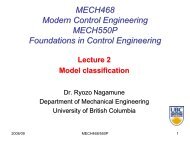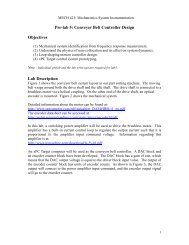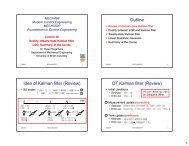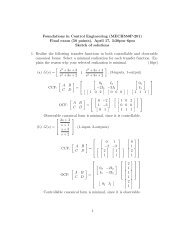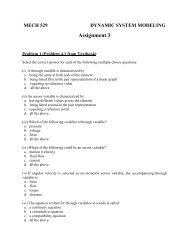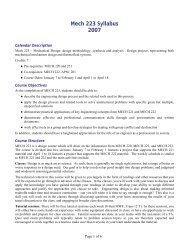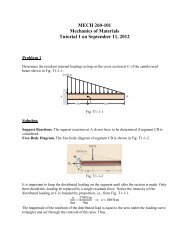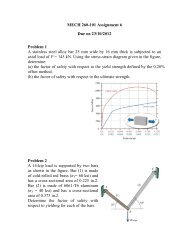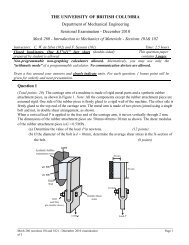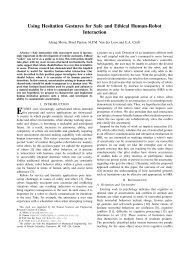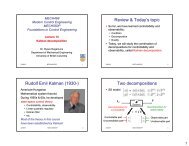Dynamic System Modeling Presentation Part 1 - UBC Mechanical ...
Dynamic System Modeling Presentation Part 1 - UBC Mechanical ...
Dynamic System Modeling Presentation Part 1 - UBC Mechanical ...
You also want an ePaper? Increase the reach of your titles
YUMPU automatically turns print PDFs into web optimized ePapers that Google loves.
MECH 469/529: <strong>Modeling</strong> of <strong>Dynamic</strong> <strong>System</strong>s; 3 Credits, 1st Term, 2012/13<br />
Tuesdays and Thursdays (MacLeod 220), 5:00 to 6:30pm<br />
Course Web Site: www.mech.ubc.ca/~ial (Courses MECH 529)<br />
Instructor: Dr. Clarence W. de Silva, Professor<br />
Office: CEME 2071; Telephone: 604-822-6291; e-mail: desilva@mech.ubc.ca<br />
Teaching Assistant: Mr. Shawn Zhang<br />
Office: ICICS 065; Tel: 604-822-4850; e-mail: yfzhang83@gmail.com<br />
Prerequisites: This course is particularly suitable for senior undergraduate and entry-level<br />
graduate engineering students. There are no specific prerequisites. But, students who have<br />
already taken introductory courses in circuit analysis, dynamics, fluid mechanics, and<br />
thermodynamics (or energy conversion) will be at an advantage.<br />
Objectives<br />
The course deals with the methodology of understanding and modeling a physical engineering<br />
system. The primary emphasis will be on the engineering problem of modeling rather than the<br />
applied mathematics of response analysis (and simulation) once a model is available.<br />
The students will learn to understand and model mechanical, thermal, fluid and electrical<br />
systems in a systematic and unified/integrated manner. For example, identification of lumped<br />
elements such as sources, capacitors, inductors, and resistors in different types of physical<br />
systems will be studied. Analogies among the four main types of systems (mechanical, thermal,<br />
fluid and electrical) will be presented in terms of these basic lumped elements and in terms of the<br />
system variables. Concepts of through and across variables, and flow and effort variables will be<br />
introduced. Multi-domain (or mixed) systems which consist of two or more of the basic system<br />
types will be considered as well.<br />
Tools of modeling and model-representation such as linear graphs and block diagrams will be<br />
discussed. Important considerations of input, output, causality, and system order will be examined.<br />
Thevenin and Norton equivalent circuits and their application to mechanical systems using linear<br />
graphs will be studied. A brief overview of response analysis will be given.<br />
Textbook: de Silva, C.W., <strong>Modeling</strong> and Control of Engineering <strong>System</strong>s, Taylor & Francis/CRC Press,<br />
Boca Raton, FL, 2009.




